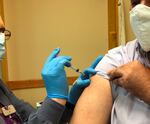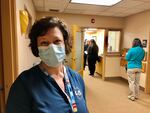
A health worker injects the Moderna COVID-19 vaccine into a ready arm at the Coquille Tribe's March 10, 2021, vaccination clinic.
Brian Bull / KLCC
When Donna Woods of Keizer died before Thanksgiving last year, it was from a brain aneurysm, not COVID-19. The pandemic cast its omnipresent shadow over the funeral all the same.
“The Catholic Church in Keizer at that time was [allowing] 50 people inside the church, 50 in a different part of the church,” recalled Woods’ surviving sister, Dee Pigsley. “Our family, when we have a service, it’s usually around a couple hundred people.”
As chairwoman for the Confederated Tribes of Siletz Indians, Pigsley has seen the pandemic shutter everything but the tribal health clinic in the past year. This has affected people’s ability to gather, whether for pow-wows or funerals.
“We’ve had to tell people they can’t come, because that’s the way it is.”
But Pigsley is pleased that her tribe is pushing back against the pandemic — through vaccinations. As of early March, the Confederated Tribes of Siletz Indians had inoculated one fourth of enrolled members and the Chinook Wind Casino had reopened, firing up one of the tribe’s biggest economic engines.
“Tribes deserve a lot of credit,” said Bryan Mercier, Northwest Regional Director for the Bureau of Indian Affairs. He said a network of Indian Health Service clinics and tight community bonds have boosted vaccination efforts on reservations. He recalls a stark contrast from earlier this year.
“The Confederated Tribes of Umatilla in Mission, Oregon, had done something like 700 shots in arms, when their neighboring county had only done less than ten at that time,” Mercier said.
There are trust issues that go back decades. Chronic underfunding of the Indian Health Service, as well as cases of native women being sterilized without their knowledge or consent, have made many Native Americans wary of government health initiatives. This includes people who live in urban areas, like Se-ah-dom Edmo.
“Early on in the pandemic, when Seattle Indian Health was requesting PPE for residents, they were sent hundreds of body bags,” Edmo recalled. “While it may have been a mistake, it sent a message about how we’re thought of in terms of the larger, whiter society.”
Edmo lives with her family in the Portland area, where she works as executive director for the MRG Foundation. She told KLCC that Oregon Governor Kate Brown’s prioritization of teachers ahead of seniors for the vaccine troubled Native American families like hers.
“Because we live in multigenerational households, there would be no way I would send my children back to school without my parents being vaccinated first,” Edmo said.
“With our elders not prioritized, it’s putting our elders at risk if we’re sending our children out to be engaged with folks not in our bubble.”
Brown’s office did not respond to requests for comment. The prioritization was announced in January after state officials learned the Trump administration had no federal reserve of vaccine doses. As of March 1, seniors 65 and older across Oregon can be vaccinated.
The Oregon Health Authority said that as of March 9, 14,077 people identifying as American Indian or Alaska Native have been vaccinated against COVID-19, 2% of the 750,486 people vaccinated so far. According to the U.S. Census Bureau, 1.8% of Oregon’s 4 million residents identify as American Indian or Alaska Native.
Tribes get their vaccines from either the Indian Health Service or the state, then set their own priorities outside what other governments do. An Urban Indian Health Institute survey shows 75% of American Indians and Alaska Natives want the COVID-19 vaccine. But 40% report having trouble knowing where to go.
Edmo said the Native Wellness Institute connected her to a Portland vaccine clinic. Other Portlanders, like Tlingit member Vikki Mata, have relied on the so-called “moccasin telegraph” and social media.
“For an urban Indian, you have to know where to go to find that information,” Mata said.
“I had learned about Grand Ronde’s clinic because of information that I received anecdotally, on Facebook.”
Mata said a Native American friend cued her in on regional tribal clinics. He himself drove from Portland to Pendleton for his COVID-19 shot, after having lost his mother to the coronavirus.
Some tribes across the Pacific Northwest are inoculating non-tribal members and those living with Native Americans, such as spouses. This includes the Coquille Indian Tribe. It’s held vaccine clinics at facilities well beyond Coos Bay, including in Eugene.

Kelle Little, Health and Human Services Director for the Coquille Indian Tribe, at a vaccination clinic event at the Ko-Kwel clinic in Eugene earlier this month.
Brian Bull / KLCC
“We have provided over 2,000 vaccine doses, which is close to 1,300 people,” Kelle Little, health and human services director for the Coquille, said at a March 10 event.
“At this point, we have provided vaccine to over 80% of the Coquille tribal elders, and spouses who live within southwestern Oregon.”
And a partnership between the Columbia River Intertribal Fish Commission, One Community Health, and The Next Door has enabled a mobile vaccination van to reach tribal people in the Columbia River Basin.
“It’s a lot of effort if you’re 200 or 300 miles away from your reservation,” said Columbia River Intertribal Fish Commission public affairs specialist Jeremy FiveCrows, who added that a “brute force” sign-up effort by their partners got folks scheduled for 100 doses at Celilo Falls on the first day vaccinating there.
FiveCrows said Native American people are determined to protect their families, elders, and culture.
“You wonder how much of that is from the cultural memory of how other pandemics swept through the tribal populations and decimated us.”
Variants and other factors may still offset efforts to rein in COVID-19. But tribal officials like Dee Pigsley are longing for something close to normalcy this summer.
“I’m hoping that we’re able to have some our tribal events like our pow-wow and our restoration activity,” she said. “People just wanna get together and shake hands, and give a hug!”
Support for this coverage comes from Underscore, a Portland, Oregon-based public service journalism organization.
Copyright 2021, KLCC.